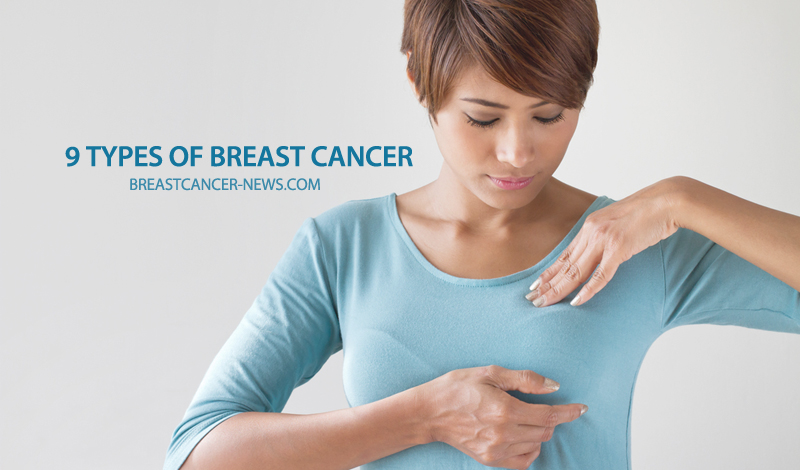 Breast cancer is a malignant disease that occurs when the cells in the breast start to grow out of control. The exact causes of the disease are unknown, but the development of breast cancer has been found to be related to acquired or inherited gene mutations. Understanding the different types of breast cancer can help tailor a more effective treatment plan as well as provide a clearer prognosis. Here’s a list of nine types of breast cancer you should know about:
Breast cancer is a malignant disease that occurs when the cells in the breast start to grow out of control. The exact causes of the disease are unknown, but the development of breast cancer has been found to be related to acquired or inherited gene mutations. Understanding the different types of breast cancer can help tailor a more effective treatment plan as well as provide a clearer prognosis. Here’s a list of nine types of breast cancer you should know about:
1. Ductal Carcinoma in Situ (DCIS): Ductal carcinoma in situ (DCIS) is the second most common type of breast cancer, and it is classified as non-invasive cancer. Carcinoma means cancer while in situ refers to the fact that it is confined to its original site. Ductal carcinoma in situ is usually an early stage cancer and highly treatable. However, if not treated, the cancer may spread into the surrounding breast tissue and beyond.
2. Invasive Ductal Carcinoma: Invasive ductal carcinoma is similar to ductal carcinoma in situ, sharing the place of origin, but here the cancer is not limited to the ducts. “The abnormal cancer cells that began forming in the milk ducts have spread beyond the ducts into other parts of the breast tissue. Invasive cancer cells can also spread to other parts of the body. IDC is also the type of breast cancer that most commonly affects men,” the Breast Cancer Foundation, Inc., said.
3. Triple Negative Breast Cancer: Triple negative breast cancer gets its name from the absence of the three most common types of receptors responsible for breast cancer growth. In patients diagnosed with triple negative breast cancer, estrogen, progesterone, and the HER-2/neu gene are not present in the cancer tumor. While common treatments like hormone therapy and drugs target these receptors, the absence of estrogen, progesterone, and the HER-2/neu gene makes these treatments ineffective. Therefore, chemotherapy tends to be the only option for triple-negative breast cancer patients.
4. Inflammatory Breast Cancer: is both aggressive and fast growing. In patients with this form of the disease, cancer cells infiltrate the skin and lymph vessels of the breast. However, in the majority of the cases, a breast lump or mass cannot be felt, which may delay the diagnosis. Symptoms are usually only noticeable when the cancer blocks the lymph vessels. These include persistent itching, a rash or small irritation similar to an insect bite, redness, swelling, and warmth in the breast, and nipple inversion, flattening, or dimpling.
5. Metastatic Breast Cancer: represents stage 4 of the disease, during which cancer has spread to other parts of the body. Cancer spread may occur when cancer cells invade nearby healthy cells, cancer cells penetrate into the circulatory or lymph system, cancer cells migrate through circulation, cancer cells lodge in capillaries, or when new small tumors grow. Symptoms vary according to how far the cancer has spread.
6. Medullary carcinoma: This is a rare type of breast cancer and it accounts for 3-5% of all breast cancer types. The tumor usually shows up on a mammogram, but does not always feel like a lump. At times, it feels like a spongy change of breast tissue.
7. Tubular carcinoma: Also a rare type of breast cancer; just about 2% of all cases are of tubular carcinoma, a type of cancer where the cells have a distinctive tubular structure when viewed under a microscope and can feel like a spongy area of breast tissue instead of a lump.
8. Mucinous carcinoma: Another rare type of breast cancer, mucinous carcinoma represents about 1% to 2% of all breast cancers, and it causes the production of mucus with poorly defined cells.
9. Paget’s disease: Paget’s disease is particularly rare and affects the skin of the nipple and areola.
Read more about these different types of cancer here: http://bit.ly/1SOz3rZ
Breast Cancer News is strictly a news and information website about the disease. It does not provide medical advice, diagnosis or treatment. This content is not intended to be a substitute for professional medical advice, diagnosis, or treatment. Always seek the advice of your physician or other qualified health provider with any questions you may have regarding a medical condition. Never disregard professional medical advice or delay in seeking it because of something you have read on this website.
